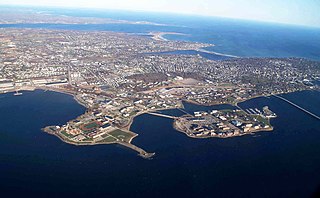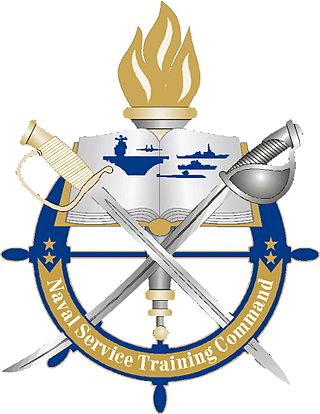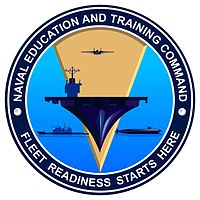The United States Armed Forces are the military forces of the United States. The armed forces consist of six service branches: the Army, Marine Corps, Navy, Air Force, Space Force, and Coast Guard. All six armed services are among the eight uniformed services of the United States.

Naval Station Newport is a United States Navy base located in the city of Newport and the town of Middletown, Rhode Island. Naval Station Newport is home to the Naval War College and the Naval Justice School. It once was the homeport for Cruiser Destroyer Force Atlantic (COMCRUDESLANT), which relocated to Naval Station Norfolk in the early 1970s. In 1989 the base was added to the National Priorities List, after contamination had been discovered years earlier. Newport now maintains inactive ships at its pier facilities, along with the United States Coast Guard and National Oceanic and Atmospheric Administration research vessels. In BRAC 2005, NAVSTA Newport gained over five hundred billets, in addition to receiving, again, the Officer Candidate School (OCS), the Naval Supply Corps School, and several other activities, to include a few Army Reserve units.

The surface warfare insignia is a military badge of the United States Navy which is issued to U.S. Navy personnel who are trained and qualified to perform duties aboard United States surface warships. There are presently four classes of the surface warfare pin, being that of line, staff, special operations, and enlisted. The line and enlisted surface warfare badges may be earned by United States Coast Guard personnel assigned to Navy commands. The various badge types are as follows:

The United States Navy's Center for Information Warfare Training (CIWT) is one of the learning centers of Naval Education and Training Command, headquartered on Naval Air Station Pensacola Corry Station in Escambia County, Florida. It is responsible for the development of education and training policies for over 26,000 members of the Information Warfare Corps in the fields of cryptology and intelligence, along with the cyber realms of information operations and technology, and computer systems and networks. The center also oversees Language, Regional Expertise and Culture.

Naval Air Station Pensacola or NAS Pensacola, "The Cradle of Naval Aviation", is a United States Navy base located next to Warrington, Florida, a community southwest of the Pensacola city limits. It is best known as the initial primary training base for all U.S. Navy, Marine Corps and Coast Guard officers pursuing designation as naval aviators and naval flight officers, the advanced training base for most naval flight officers, and as the home base for the United States Navy Flight Demonstration Squadron, the precision-flying team known as the Blue Angels.

Insignias and badges of the United States Navy are military badges issued by the United States Department of the Navy to naval service members who achieve certain qualifications and accomplishments while serving on both active and reserve duty in the United States Navy. Most naval aviation insignia are also permitted for wear on uniforms of the United States Marine Corps.

The United States Navy Reserve (USNR), known as the United States Naval Reserve from 1915 to 2005, is the Reserve Component (RC) of the United States Navy. Members of the Navy Reserve, called Reservists, are categorized as being in either the Selected Reserve (SELRES), the Training and Administration of the Reserve (TAR), the Individual Ready Reserve (IRR), or the Retired Reserve.

The Indonesian Navy is the naval branch of the Indonesian National Armed Forces. It was founded on 10 September 1945 and has a role to patrol Indonesia's lengthy coastline, to enforce and patrol the territorial waters and Exclusive Economic Zone (EEZ) of Indonesia, to protect Indonesia's maritime strategic interests, to protect the islands surrounding Indonesia, and to defend against seaborne threats.

The Naval Aviation Warfighting Development Center was formerly known as the Naval Strike and Air Warfare Center at Naval Air Station Fallon located in the city of Fallon in western Nevada. It is the center of excellence for naval aviation training and tactics development. NAWDC provides service to aircrews, squadrons and air wings throughout the United States Navy through flight training, academic instructional classes, and direct operational and intelligence support. The name was changed from NSAWC to NAWDC in June 2015 to align with the naming convention of the Navy's other Warfighting Development Centers (including Naval Surface and Mine Warfighting Development Center, Naval Information Warfighting Development Center, and the Undersea Warfighting Development Center.

Operations Specialist is a United States Navy and United States Coast Guard occupational rating. It is a sea duty-intensive rating in the Navy while most of Coast Guard OS's are at ashore Command Centers.
The structure of the United States Navy consists of four main bodies: the Office of the Secretary of the Navy, the Office of the Chief of Naval Operations, the operating forces, and the Shore Establishment.

The Navy Supply Corps School (NSCS) is a 21-week training and "Basic Qualification Course" (BQC) in the United States located in Newport, Rhode Island. Those who successfully complete the course are designated officers in the Navy Supply Corps. The commanding officer is Captain Jason Warner, and the Executive Officer is Commander Jennifer Charlton.

The Operational Test and Evaluation Force (OPTEVFOR) is an independent and objective agency within the United States Navy for the operational testing and evaluation (OT&E) of naval aviation, surface warfare, submarine warfare, C4I, cryptologic, and space systems in support Navy and Department of Defense acquisition programs.

The United States Navy (USN) is the maritime service branch of the United States Armed Forces and one of the eight uniformed services of the United States. It is the world's most powerful navy and the largest by tonnage, at 4.5 million tons in 2021 and in 2009 an estimated battle fleet tonnage that exceeded the next 13 navies combined. It has the world's largest aircraft carrier fleet, with 11 in service, 1 undergoing trials, two new carriers under construction, and six other carriers planned as of 2024. With 336,978 personnel on active duty and 101,583 in the Ready Reserve, the U.S. Navy is the third largest of the United States military service branches in terms of personnel. It has 299 deployable combat vessels and about 4,012 operational aircraft as of July 18, 2023.

In the United States Navy, United States Coast Guard, United States Public Health Service Commissioned Corps (USPHS), and National Oceanic and Atmospheric Administration Commissioned Officer Corps, captain is the senior-most commissioned officer rank below that of flag officer. The equivalent rank is colonel in the United States Army, Air Force, Space Force, and Marine Corps.

The Master-at-Arms (MA) rating is responsible for law enforcement and force protection in the United States Navy—equivalent to the United States Army Military Police, the United States Marine Corps Military Police, the United States Air Force Security Forces, and the United States Coast Guard's Maritime Law Enforcement Specialist. It is one of the oldest ratings in the United States Navy, having been recognized since the inception of the U.S. Navy.

The Naval Service Training Command (NSTC) is a one-star echelon III command of the United States Navy that is responsible to the Chief of Naval Education and Training for the indoctrination and training of all new accessions into the Naval Service, with the exception of Midshipmen who access through the United States Naval Academy. This includes all new recruits through Recruit Training Command, the Navy's only enlisted recruit training location and all Officer "Candidates" who are seeking a commission through the Officer Training Command at Naval Station Newport, Rhode Island. Also under its purview is the operation of the various Naval Reserve Officers Training Corps (NROTC) units in universities across the country. The current NSTC is Rear Admiral Craig T. Mattingly.

The Center for Surface Combat Systems (CSCS) is one of eleven learning centers of Naval Education and Training Command, headquartered on Naval Support Facility Dahlgren operated learning centers for the education and training of United States Navy personnel on the operation and use of shipboard combat systems, including the Aegis Combat System, SSDS, tactical data links and other systems that can be used in the ship's combat information center (CIC). Through 70,000 hours' worth of curriculum in 700 courses, CSCS provides the fleet with highly trained surface warfare officers and enlisted personnel in the ratings of fire controlmen, electronic technicians, interior communications electricians, sonar technicians (surface), gunner's mates, minemen, operations specialists, and boatswain's mates.

The United States Navy Center for Explosive Ordnance Disposal and Diving (CENEODDIVE) is one of the eleven learning centers responsible for training explosive ordnance disposal technicians and divers in the United States. CENEODDIVE is stationed on Naval Support Activity Panama City (NSA PC) in Florida and forms a part of the Naval Education and Training Command. With the exception of the Great Lakes learning site, CENEODDIVE is the only inter-service learning center.



















